Do you have a question about the Deye SUN-5K-SG and is the answer not in the manual?
Steps for safely opening the inverter housing and disconnecting power before service.
Diagnose reverse DC input polarity fault by checking PV panel connections.
Address DC insulation impedance fault by checking grounding and internal cables.
Troubleshoot DC leakage current fault by checking fuse and potential component damage.
Identify ground fault by checking solar panel output terminals connection.
Address memory read errors by restarting and checking connections.
Resolve memory write errors by restarting and checking connections.
Troubleshoot DC/DC softstart fault caused by low bus voltage.
Note: GFDI grounding touch failure is not related to this machine.
Note: IGBT damage by voltage drop is not related to this machine.
Diagnose Aux Power Board failure by checking MCU 12V power supply.
Troubleshoot AC main contactor errors by restarting the inverter.
Resolve AC auxiliary contactor errors by restarting the inverter.
Indicates working mode change, phase loss, or relay issues.
Note: DC firmware over current is not related to this machine.
Note: AC firmware over current is not related to this machine.
Note: GFCI AC leakage current fault is not related to this machine.
Note: Three phase over-current fault is not related to this machine.
Address AC current over max-limit by checking load power and firmware.
Note: This memory error is not related to this machine.
Troubleshoot DC over current hardware fault by checking PV/battery connections.
Note: DC leakage flow fault is not related to this machine.
Address Tz Emergency Stop Fault by checking GND connection.
Diagnose AC leakage current transient fault by checking leakage sensor.
Resolve DC insulation impedance failure by checking PV panel and PE cable connections.
Note: DC feedback fault is not related to this machine.
Note: DC busbar imbalance is not related to this machine.
Note: DC end insulation error is not related to this machine.
Note: Inverter 1 DC high fault is not related to this machine.
Troubleshoot parallel CANBus fault by checking settings and connections.
Note: AC main contactor failure is not related to this machine.
Note: DC boost soft start is not related to this machine.
Note: Inverter 2 DC high fault is not related to this machine.
Note: AC over current is not related to this machine.
Note: AC current over load is not related to this machine.
Address 'No AC Grid' fault by confirming grid connection and status.
Note: AC grid phase error is not related to this machine.
Note: AC voltage unbalance failure is not related to this machine.
Note: AC current unbalance failure is not related to this machine.
Note: AC over current (one cycle) is not related to this machine.
Note: DC over current is not related to this machine.
Address parallel system stop faults due to other inverter issues.
Troubleshoot AC line low voltage by checking AC voltage and cable connections.
Note: AC line V,W over voltage is not related to this machine.
Note: AC line V,W low voltage is not related to this machine.
Note: AC line U,V over voltage is not related to this machine.
Address backup battery faults by checking capacity and connections.
Troubleshoot AC over frequency by checking frequency and cable connections.
Note: AC lower frequency is not related to this machine.
Address backup battery faults by checking capacity and connections.
Note: V phase grid current fault is not related to this machine.
Note: W phase grid current fault is not related to this machine.
Note: AC inductor B current fault is not related to this machine.
Note: This memory error is not related to this machine.
Note: AC inductor C current fault is not related to this machine.
Address high DC busbar voltage by checking PV or battery voltage.
Resolve low DC busbar voltage by checking battery voltage.
Note: AC reverse irrigation is not related to this machine.
Check battery discharge current is within allowed range.
Note: AC grid V over current is not related to this machine.
Note: AC grid W over current is not related to this machine.
Note: Reactor A phase over current is not related to this machine.
Note: Reactor B phase over current is not related to this machine.
Address ARC fault by checking PV module cable connection.
Resolve heat sink high temperature by checking environment and restarting.
Steps for measuring IGBT and diode voltage drop using a multimeter.
Instructions for setting multimeter and measuring IGBT S-level and D-level.
Procedure for measuring the voltage drop of the boost diode.
Identify and replace IGBT drive components and resistors.
Ensure all damaged IGBTs are replaced and pay attention to component direction.
Replace marked components corresponding to damaged IGBTs.
Verify inductor harness integrity and check for direct contact with the shell.
Procedure for installing the control panel and plugging in harnesses.
Insert inductive wire terminals into motherboard positions, following line labels.
Connect the 60P gray line to the motherboard and control board.
Replace capacitor plate and secure cables with screws.
Pass button switch cable and connect AC wire, yellow green line.
Install the top cover, test the machine, and seek service if problems persist.
Steps for safely opening the inverter housing and disconnecting power before service.
Diagnose reverse DC input polarity fault by checking PV panel connections.
Address DC insulation impedance fault by checking grounding and internal cables.
Troubleshoot DC leakage current fault by checking fuse and potential component damage.
Identify ground fault by checking solar panel output terminals connection.
Address memory read errors by restarting and checking connections.
Resolve memory write errors by restarting and checking connections.
Troubleshoot DC/DC softstart fault caused by low bus voltage.
Note: GFDI grounding touch failure is not related to this machine.
Note: IGBT damage by voltage drop is not related to this machine.
Diagnose Aux Power Board failure by checking MCU 12V power supply.
Troubleshoot AC main contactor errors by restarting the inverter.
Resolve AC auxiliary contactor errors by restarting the inverter.
Indicates working mode change, phase loss, or relay issues.
Note: DC firmware over current is not related to this machine.
Note: AC firmware over current is not related to this machine.
Note: GFCI AC leakage current fault is not related to this machine.
Note: Three phase over-current fault is not related to this machine.
Address AC current over max-limit by checking load power and firmware.
Note: This memory error is not related to this machine.
Troubleshoot DC over current hardware fault by checking PV/battery connections.
Note: DC leakage flow fault is not related to this machine.
Address Tz Emergency Stop Fault by checking GND connection.
Diagnose AC leakage current transient fault by checking leakage sensor.
Resolve DC insulation impedance failure by checking PV panel and PE cable connections.
Note: DC feedback fault is not related to this machine.
Note: DC busbar imbalance is not related to this machine.
Note: DC end insulation error is not related to this machine.
Note: Inverter 1 DC high fault is not related to this machine.
Troubleshoot parallel CANBus fault by checking settings and connections.
Note: AC main contactor failure is not related to this machine.
Note: DC boost soft start is not related to this machine.
Note: Inverter 2 DC high fault is not related to this machine.
Note: AC over current is not related to this machine.
Note: AC current over load is not related to this machine.
Address 'No AC Grid' fault by confirming grid connection and status.
Note: AC grid phase error is not related to this machine.
Note: AC voltage unbalance failure is not related to this machine.
Note: AC current unbalance failure is not related to this machine.
Note: AC over current (one cycle) is not related to this machine.
Note: DC over current is not related to this machine.
Address parallel system stop faults due to other inverter issues.
Troubleshoot AC line low voltage by checking AC voltage and cable connections.
Note: AC line V,W over voltage is not related to this machine.
Note: AC line V,W low voltage is not related to this machine.
Note: AC line U,V over voltage is not related to this machine.
Address backup battery faults by checking capacity and connections.
Troubleshoot AC over frequency by checking frequency and cable connections.
Note: AC lower frequency is not related to this machine.
Address backup battery faults by checking capacity and connections.
Note: V phase grid current fault is not related to this machine.
Note: W phase grid current fault is not related to this machine.
Note: AC inductor B current fault is not related to this machine.
Note: This memory error is not related to this machine.
Note: AC inductor C current fault is not related to this machine.
Address high DC busbar voltage by checking PV or battery voltage.
Resolve low DC busbar voltage by checking battery voltage.
Note: AC reverse irrigation is not related to this machine.
Check battery discharge current is within allowed range.
Note: AC grid V over current is not related to this machine.
Note: AC grid W over current is not related to this machine.
Note: Reactor A phase over current is not related to this machine.
Note: Reactor B phase over current is not related to this machine.
Address ARC fault by checking PV module cable connection.
Resolve heat sink high temperature by checking environment and restarting.
Steps for measuring IGBT and diode voltage drop using a multimeter.
Instructions for setting multimeter and measuring IGBT S-level and D-level.
Procedure for measuring the voltage drop of the boost diode.
Identify and replace IGBT drive components and resistors.
Ensure all damaged IGBTs are replaced and pay attention to component direction.
Replace marked components corresponding to damaged IGBTs.
Verify inductor harness integrity and check for direct contact with the shell.
Procedure for installing the control panel and plugging in harnesses.
Insert inductive wire terminals into motherboard positions, following line labels.
Connect the 60P gray line to the motherboard and control board.
Replace capacitor plate and secure cables with screws.
Pass button switch cable and connect AC wire, yellow green line.
Install the top cover, test the machine, and seek service if problems persist.
The Deye 5KW Storage Inverter is a sophisticated device designed for managing and converting solar energy, offering robust functionality for both residential and commercial applications. This guide provides comprehensive instructions for its repair and maintenance, highlighting its modular design and the importance of precise handling during service.
The Deye 5KW Storage Inverter primarily functions as a central unit for solar power systems, converting direct current (DC) generated by solar panels into alternating current (AC) suitable for household use or feeding into the grid. It also incorporates storage capabilities, allowing excess energy to be stored in batteries for later use, enhancing energy independence and reliability. The inverter is equipped with various protection mechanisms to ensure safe and efficient operation, including safeguards against DC input polarity reversal, insulation impedance faults, DC leakage current, ground faults, and AC overcurrents. It can operate in parallel mode, allowing multiple inverters to work together for increased power output and system redundancy. The device's control system monitors critical parameters such as bus voltage, AC line voltage, and frequency, adjusting its operation to maintain optimal performance and protect against anomalies. Its ability to manage both PV input and battery storage makes it a versatile solution for hybrid solar energy systems.
The inverter is designed for user-friendly operation, though its internal components require careful handling during maintenance. Key usage features include:
Maintenance of the Deye 5KW Storage Inverter is designed to be systematic, with a strong emphasis on safety and precision. The repair guide outlines several key maintenance features:
In summary, the Deye 5KW Storage Inverter is a robust and repairable device, designed with an emphasis on diagnostic clarity and systematic maintenance procedures. Its comprehensive error code system, modular construction, and detailed repair instructions empower technicians to efficiently troubleshoot and restore the inverter to optimal working condition, ensuring reliable solar energy management.
| Type | Hybrid Inverter |
|---|---|
| Rated Power | 5kW |
| Max. DC Input Power | 6.5kW |
| Max. DC Input Voltage | 500V |
| Number of MPPT Trackers | 2 |
| Nominal AC Output Power | 5kW |
| Max. AC Output Power | 5.5kW |
| AC Voltage Range | 180-280V |
| THDi | <3% |
| AC Grid Frequency Range | 50/60Hz |
| Battery Voltage Range | 40-60V |
| Max. Charging Current | 100A |
| Max. Discharging Current | 100A |
| Protection Degree | IP65 |
| Topology | Transformerless |
| Nominal AC Voltage | 230 V |
| Power Factor | 0.8 leading to 0.8 lagging |
| Communication | RS485 |
| Cooling Method | Natural Cooling |
| Operating Temperature Range | -40~60°C |


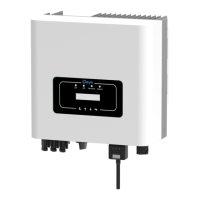
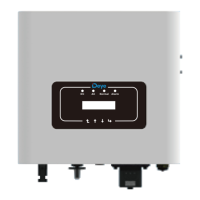

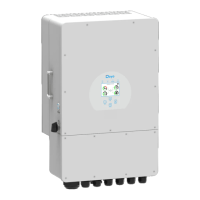
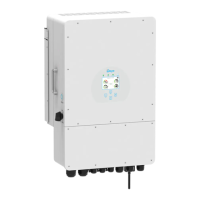
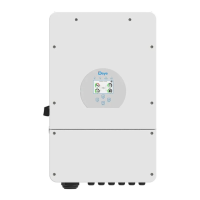



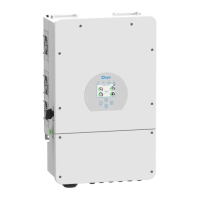
